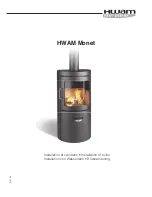
TFTN 085-199 Installation and Operation Manual
5
1.4
Before Operating with Propane
TFTN boilers are factory set to operate with Natural Gas;
BEFORE OPERATING WITH PROPANE
,
the boiler must be converted using the appropriate
Natural Gas to LP Conversion Kit
; see below.
Failure to properly convert the unit to safely operate with Propane will cause dangerous burner
operation, resulting in property damage, serious injury or death.
Table 1-1
Natural Gas to LP Conversion Kits
Boiler Model
Natural Gas to LP Conversion Kit
(part no.)
TFTN085-110
87752
TFTN150
87753
TFTN199
87740
TFTN285
87754
Notes
:
1.
TFTN085-199 models are converted to Propane using a replacement LP-Mixer and Diaphragm insert, which are
provided in the respective Natural Gas to LP Conversion Kit; follow the instructions provided in the kit to
complete the conversion to LP.
2.
TFTN285-399 models are converted to Propane by installing an LP-Orifice, which is provided in the respective
Natural Gas to LP Conversion Kit; follow the instructions provided in the kit to complete the conversion to LP.
Liquefied Petroleum (LP) propane gas is heavier than air. Do not install the boiler in a pit or similar
location that will permit heavier than air gas to collect. Check with Local Codes as they may require
boilers fueled with LP gas to be provided with an approved means of removing unburned gases
from the room. Failure to follow these instructions may result in serious injury or death.
1.5
Boiler Vent / Air-Intake Piping
The TFTN is certified as
a “Category IV”
boiler and requires
a “Special Venting System”
designed for
pressurized venting. The exhaust gases must be piped directly to the outdoors using the vent
materials and rules outlined in these instructions. Failure to follow these instructions will result in
serious injury or death.
1.6
DHW Temperature Adjustment and Scalding
This boiler, when connected to an Indirect Water Heater (IWH) can deliver scalding water. Be careful whenever using hot
water to avoid scalding injury. Certain appliances such as dishwashers and automatic clothes washers may require
increased water temperatures. By setting the thermostat on this boiler to obtain the increased water temperature required
by these appliances you may create the potential for scald injury.
To protect against injury, install a mixing valve in the water system. This valve will reduce point of use discharge
temperatures by mixing cold and hot water in branch supply lines. Such valves are available from your local plumbing
supplier.
Table 1-2 details the relationship of water temperature and time with regard to scald injury and may be used as a guide in
determining the safest water temperature for your applications.
Table 1-2 Approximate Scald Time to Temperature Relationship
120°F
More than 5 minutes
125°F
1.5 to 2 minutes
130°F
About 30 seconds
135°F
About 10 seconds
140°F
Less than 5 seconds
145°F
Less than 3 seconds
150°F
About 1.5 seconds
155°F
About 1 second






































